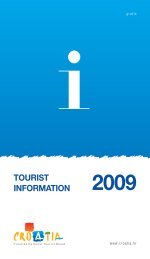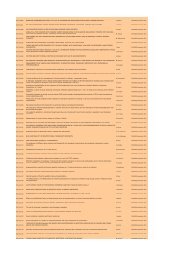Profilaksa DVT kod velikih ortopedskih operacija - Depol ...
Profilaksa DVT kod velikih ortopedskih operacija - Depol ...
Profilaksa DVT kod velikih ortopedskih operacija - Depol ...
You also want an ePaper? Increase the reach of your titles
YUMPU automatically turns print PDFs into web optimized ePapers that Google loves.
20 - 22 September 2012, Opatija, Croatia<br />
THE BIOLOGICAL TROPISM BETWEEN SYNOVIAL AND<br />
CHONDRAL TISSUES<br />
Mahmut Nedim Doral, Hacettepe University Dept. of Orthopaedics & Traumatology, Dept. of Sports<br />
Medicine, Ankara, Turkey<br />
The importance of articular cartilage lesions was first described by William Hunter in 1743. Ever since, the efforts<br />
to repair the damaged joint cartilage have been accelerating intensively through basic and clinical investigations.<br />
Arthroscopic debridement with or without intra-articular injections, perichondrial or periosteal covering, abrasion<br />
arthroplasty, microfracture, transplantation of chondrocytes, meniscal allografts, osteochondral allografts/<br />
otografts, autologous chondrocyte transplantation, tissue engineering and gene therapies are some methods to<br />
treat cartilage lesions. However, any treatment modality has enabled full restoration of the injured articular cartilage<br />
to its original phenotype yet.<br />
In recent years, mesenchymal stem cells (MSCs) have been recommended as a cell therapy to regenerate chondrocytes.<br />
MSCs are known to be present in the bone marrow and other tissues such as skeletal muscle, tendon, fatty<br />
tissue, neural tissue, hepatic tissue, periosteum and synovium. Morphological and functional characteristics of<br />
the chondral tissue formed from MSCs that are originated from various tissue types show some differences. MSCs<br />
derived from the synovium have been shown to be highly potential for chondrogenesis that presents them as an<br />
attractive source for the treatment of the damaged cartilage tissue. Intra-articular loose bodies are described as<br />
cartilaginous, osseous or osteochondral fragments located within the joint cavity and are known to be produced<br />
by the synovium. Free or pediculated ‘‘chondroosteophytes’’ that are frequently seen in arthroscopic observations<br />
and their close biological relationship with the synovial tissue formed the basis of our study, in which the hypothesis<br />
was that ‘‘the synovial tissue might have a pivotal role in the formation and growth of intra-articular<br />
chondro-osteophytes and might exert similar growth effects on transplanted cartilaginous tissue grafts’’. So we<br />
aimed to assess the applicability of the use of synovium as an in vivo chondrocyte culture medium and to evaluate<br />
the effects of the synovial tissue on chondrocyte growth in a rabbit model study. We tried to determine the<br />
effects of synovium on cartilage proliferation as “in-vivo” culture medium and to anticipate a new, biological and<br />
cheap treatment method for the articular cartilage pathologies. In our study, 12 New Zealand rabbits were used<br />
and standardized cartilage samples were taken from both knees. Two groups were formed: In group I (synovium<br />
group), the cartilage samples were placed into the synovial tissue on the supracondylar groove, and in group II (intraarticular<br />
group), behind the patellar tendon. After 4 months, we sized and analyzed samples histologically with<br />
the camera lucida method to count the chondrocyte numbers (Mann-Whitney U-Test and regression analysis).<br />
The chondrocyte numbers in the osteochondral samples were found to be higher than chondral samples (p




